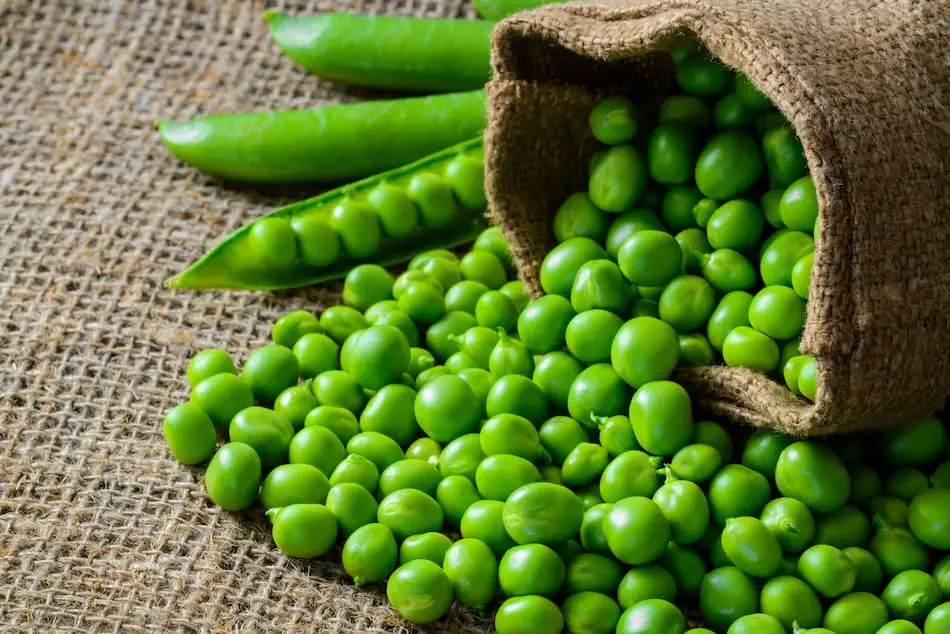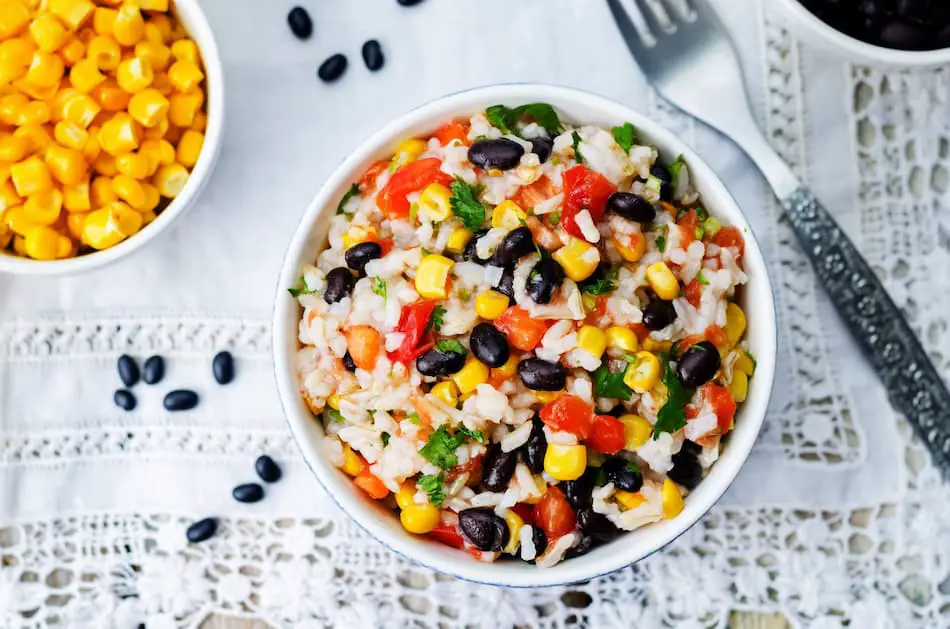
Many people don’t realize that vegetables can be good sources of protein. And veggies are healthy for you in so many additional ways, as they are usually high in fiber, vitamins, minerals and phytonutrients. So which vegetable is highest in protein?
Peas are the highest-protein vegetable. They provide 5.42 grams of protein per 100-gram serving. Brussels sprouts are second-highest in protein at 3.38 grams per serving, and oyster mushrooms are third-highest in protein at 3.31 grams per serving.
For comparison, one serving of peas provides a bit more than half the protein of one egg, which has 10.7 grams of protein per serving. So peas are not on a par with eggs in protein, but they are a significant source. Note that “serving size” in my table below is defined as 100 grams, which equates to 1/2 to 3/4 cup of vegetables. That’s a relatively small amount, so you could easily increase the amount of veggies you eat in a meal to increase the protein content.
Peas are so high in protein, they provide 7 times more than the lowest-protein vegetable among those tested, which is spaghetti squash, at 0.64 grams per serving. And peas provide about 60% more protein than Brussels sprouts, the second-highest protein vegetable tested.
By the way, peas are technically a legume, but the USDA classifies them as a starchy vegetable, given their similarity to other starchy veggies in terms of their nutrition and how they are eaten1.
In a further testament to their value as a protein source, USDA categorizes peas in the protein group, along with meat and beans, as well as in the vegetable group2.
Peas are also very high in fiber—see my article here on the highest-fiber vegetables, where peas come in second place. Given their high-fiber, high-protein status, perhaps peas should be considered a super-food like blueberries and kale!
Top 10 Vegetables Highest in Protein
Of the 77 vegetables tested, here are the top 10 in order by protein content, from highest to lowest:
- Peas (green), 5.42g
- Brussels sprouts, 3.38g
- Oyster mushrooms, 3.31g
- Artichokes and Corn , 3.27g (tied)
- Broccoli Rabe, 3.17g
- Morel Mushrooms, 3.12g
- White Mushrooms, 3.09g
- Collard Greens, 3.02g
- Kale, 2.92g
- Mustard Greens, 2.86g
| VEGETABLE (100 grams raw, except where noted = 1/2 to 3/4 cups) | Protein (grams) | % DV Women* | %DV Men* |
| Artichoke | 3.27 | 7% | 6% |
| Arugula (AKA rocket; Italian Cress) | 2.58 | 6% | 5% |
| Asparagus | 2.2 | 5% | 4% |
| Avocado | 1.96 | 4% | 4% |
| Bamboo Shoots | 2.6 | 6% | 5% |
| Beet | 1.61 | 4% | 3% |
| Broccoli | 2.82 | 6% | 5% |
| Broccoli Rabe | 3.17 | 7% | 6% |
| Brussels Sprouts | 3.38 | 7% | 6% |
| Butterhead (includes Bibb and Boston) | 1.35 | 3% | 2% |
| Cabbage, Green | 1.28 | 3% | 2% |
| Cabbage, Red | 1.43 | 3% | 3% |
| Carrot | 0.93 | 2% | 2% |
| Cauliflower | 1.92 | 4% | 3% |
| Celery | 0.69 | 2% | 1% |
| Celery Root (Celeriac) | 1.5 | 3% | 3% |
| Chinese Cabbage (AKA Napa Cabbage; Pak-choi; Bok Choy) | 1.5 | 3% | 3% |
| Collard Greens | 3.02 | 7% | 5% |
| Corn | 3.27 | 7% | 6% |
| Cucumber | 0.65 | 1% | 1% |
| Daikon (cooked) | 0.67 | 1% | 1% |
| Dandelion Greens | 2.7 | 6% | 5% |
| Eggplant (AKA Aubergine) | 0.98 | 2% | 2% |
| Endive | 1.25 | 3% | 2% |
| Escarole (Frisée and Curly Endive are closely related) | 1.18 | 3% | 2% |
| Fennel | 1.24 | 3% | 2% |
| Green Beans | 1.83 | 4% | 3% |
| Green Leaf (AKA Leaf Lettuce) | 1.36 | 3% | 2% |
| Green Pepper | 0.72 | 2% | 1% |
| Iceberg (AKA Crisphead) | 0.9 | 2% | 2% |
| Jicama (AKA Yambean) | 0.72 | 2% | 1% |
| Kale | 2.92 | 6% | 5% |
| Kohlrabi | 1.7 | 4% | 3% |
| Leeks | 1.5 | 3% | 3% |
| Mushrooms, Chanterelle | 1.49 | 3% | 3% |
| Mushrooms, Enoki | 2.66 | 6% | 5% |
| Mushrooms, Maitake | 1.94 | 4% | 3% |
| Mushrooms, Morel | 3.12 | 7% | 6% |
| Mushrooms, Oyster | 3.31 | 7% | 6% |
| Mushrooms, Portabella | 2.11 | 5% | 4% |
| Mushrooms, Shiitake | 2.24 | 5% | 4% |
| Mushrooms, White | 3.09 | 7% | 6% |
| Mustard Greens | 2.86 | 6% | 5% |
| Okra | 1.93 | 4% | 3% |
| Onion, Red | 0.94 | 2% | 2% |
| Onion, White | 0.89 | 2% | 2% |
| Onion, Yellow | 0.83 | 2% | 1% |
| Parsnip | 1.2 | 3% | 2% |
| Peas, Green | 5.42 | 12% | 10% |
| Potato, White (baked) | 2.1 | 5% | 4% |
| Potato, Red (baked) | 2.3 | 5% | 4% |
| Pumpkin | 1.0 | 2% | 2% |
| Radicchio | 1.43 | 3% | 3% |
| Radish | 0.68 | 1% | 1% |
| Red Leaf | 1.33 | 3% | 2% |
| Red Pepper | 0.9 | 2% | 2% |
| Romaine (Little Gem is closely related) | 1.24 | 3% | 2% |
| Rutabaga | 1.08 | 2% | 2% |
| Scallions (AKA Spring Onions) | 1.83 | 4% | 3% |
| Shallots | 2.5 | 5% | 4% |
| Snow Peas | 2.35 | 5% | 4% |
| Spinach | 2.91 | 6% | 5% |
| Sugar Snap Peas | 2.8 | 6% | 5% |
| Squash, Acorn | 0.8 | 2% | 1% |
| Squash, Butternut | 1.0 | 2% | 2% |
| Squash, Hubbard | 2.0 | 4% | 4% |
| Squash, Spaghetti | 0.64 | 1% | 1% |
| Sweet Potato (cooked) | 1.71 | 4% | 3% |
| Tomatillo | 0.96 | 2% | 2% |
| Tomato, Grape | 0.83 | 2% | 1% |
| Tomato, Red | 0.88 | 2% | 2% |
| Tomato, Roma | 0.7 | 2% | 1% |
| Turnip | 0.9 | 2% | 2% |
| Watercress | 2.3 | 5% | 4% |
| Yam (baked) | 1.53 | 3% | 3% |
| Yellow Pepper | 1.0 | 2% | 2% |
| Zucchini (AKA Courgette) | 1.21 | 3% | 2% |
Source: USDA FoodData Central
* Per USDA guidance of 46 grams for the average adult woman, and 56 grams for the average adult man. Your protein needs may vary. Percents have been rounded.
For the purposes of this analysis, I define vegetables as plants that are eaten via the leaves, stems, roots, tubers, bulbs, flowers and savory fruits. So I’ve omitted beans, lentils, nuts, seeds, and grains (although I included green peas and corn, which are officially pulses and a grain, respectively, but are often treated as vegetables). See my article here on the healthiest beans, including fiber content, and the healthiest nuts, including fiber content, here.
Is the Protein in Vegetables a Complete Protein?
All plants contain protein. However, their amino acid content, which comprises the protein, varies by plant type. There are nine essential amino acids that humans need to get from food in order to make protein3. Most animal foods, including meat, eggs and cheese, contain significant amounts of all the essential amino acids, which make them sources of complete protein.
However, most vegetables contain small amounts of some or all of the essential amino acids, so they are said to be incomplete proteins. However, eating a variety of plants during a meal, or even the same day4, will help your body use all the amino acids to make a complete protein.
You can create a complete protein by pairing beans (pulses) and grains. For example, these meals make a complete protein:

- Rice and beans or lentils
- Hummus and wheat pita
- Beans and corn tacos
- Peanut butter on whole wheat bread
Any vegetables you add to a plant-based or meat-based meal will add protein, which will likely be complemented by the amino acid profiles of the other foods you eat.
Peas and potatoes, among all the vegetables in my table, have the most complete protein profile3. If you add rice or pasta to peas, or top a potato with cheese or beans, you make a complete protein within that meal.
Summing it Up
If you are looking to maximize your protein intake, choose vegetables that are higher in protein like peas, mushrooms or dark leafy greens. Potatoes are also a good bet because of the high quality of their protein content (also true for peas).
Just be sure to pair your veggies with higher protein foods anytime during each day to ensure your body is able to make complete proteins from your diet. Veggies are so good for you for so many reasons, their protein content is just another reason to pile them high on your plate at every meal.
Which fruit is lowest in sugar and carbs? Find out here.
Are beans high in carbs? The surprising answer is here.
One type of apple rises above the rest, nutritionally. Read about it here.
Resources
1 AskUSDA
2 2020-2025 USDA Dietary Guidelines for Americans
3 Hertzler, S. R., Lieblein-Boff, J. C., Weiler, M., & Allgeier, C. (2020). Plant Proteins: Assessing Their Nutritional Quality and Effects on Health and Physical Function. Nutrients, 12(12), 3704. https://doi.org/10.3390/nu12123704.
4 Young, V. R., & Pellett, P. L. (1994). Plant proteins in relation to human protein and amino acid nutrition. The American journal of clinical nutrition, 59(5 Suppl), 1203S–1212S. https://doi.org/10.1093/ajcn/59.5.1203S.
See Also:
